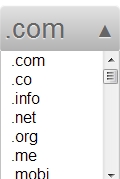Registrars are preparing domain search for new top level domain names.

It may seem like a subtle change, but it’s indicative of a big shift coming in domain search and discovery necessitated by the launch of hundreds of new top level domains.
Domain registrars must figure out how to present the most relevant domain choices to their customers from hundreds of options.
Changing the front end of domain search
Although long time domainers may fret at the absence of the TLD drop down box, Go Daddy will hardly be the first registrar to ditch this search feature.
Hover, the retail arm of reseller registrar Tucows, got rid of its TLD drop down box last year. Now, visitors are greeted with a search box that invites you to “Search for a domain or enter a few keywords”.
Furthermore, Hover’s results page is more than just the search term followed by every TLD under the sun. Hover mixes in various extensions, aftermarket domains, and variations of the search terms.
Hover isn’t the only registrar to ditch the drop down and tinker with results. MelbourneIT, a top 10 domain registrar, only shows TLD options if you click a button that says “see our domain extensions”.
It went even further with a recently launched home page that has one path: search for a domain and then go through the purchase path.
Once Go Daddy changes its search box, expect others to follow suit as smaller registrars try to emulate it.
Smarter search results
Getting rid of the TLD selector is the easy part. How do you deliver the most relevant results to customers to convert them into registrants?
In 2011 Go Daddy got a patent on an Adwords-style bidding system for registries.
It would allow registries to move their domains up in search results using a bidding system. The patent takes into consideration how often the TLD converts and how much money it generates, effectively creating a CPM system for TLD search results.
Many registrars have a crude system like this today. The TLDs that are most likely to convert (or for which the registry offers marketing dollars) move to the top of the list.
But these systems will need to get a lot more sophisticated.
The goal of domain search is conversion. If a registrar shows relevant (and available) domain options, it’s more likely to convert searches into registrations.
Some conversions are better than others. Registrars will consider how profitable each TLD registration is. Profitability might not be just measured by the initial registration. Over time, registrars will get better at determining the lifetime value of a customer that registers a particular type of domain or specific TLD.
Registrars will also consider the propensity of customers to buy additional services with a particular TLD. One reason some registrars demote .us in search results it because they can’t sell lucrative whois privacy services with it.
A couple new parameters will clearly come into play in search results in the new TLD era.
First is geolocation. It makes sense for registrars to show .nyc domains higher up on the list to someone who is located in New York City and lower on the list to someone in Austin.
Some registrars already do this for country codes, but .city domains will take this to a much more localized level.
The second is relevance of the top level domain. Right now relevance of the TLD is rarely a factor in how registrars display results. Most TLDs at the top of the list are generic, such as .com, .co or .info.
But does this make sense when someone searches for “Johns Pizza Shop”?
Perhaps it makes sense to show johns.pizza, johns.restaurant, johnspizza.restaurant, or johnspizza.food to this customer. Showing these top level domains to most consumers, such as those that search for generic terms, doesn’t make sense.
Registrars will need to determine when it makes sense to show a new top level domain ahead of .com in the search results. In the case of a search for “Johns Pizza Shop”, showing JohnsPizzaShop.com makes no sense because it is already registered. Unless it’s for sale on the aftermarket, the registrar won’t by able to convert a registration for the domain.
Search results may include other .com domains, but registrars will need to analyze their data to determine exactly what to promote for each individual search.
A big transition
This year will truly be the end of an era. Saying it’s the end of an era because of the elimination of the drop down box, a staple of domain search for over a decade, misses the point.
The bigger story is a move from “dumb search” to “smart search”. Most registrars currently have basic search systems. Give them a query, and they’ll respond with the match.
That simply won’t cut it going forward.
Smart domain search is a big, complex problem. Go Daddy is hiring search and data experts to solve the problem to prepare for a much broader TLD universe.
Registrars who solve the puzzle will gain a competitive advantage. Those that haven’t started working on a solution are running out of time.







The Choices Of What To Register & What is Best ~ Nothing Will Change My Opinion That Dot Com Is No 1
personally i find the drop down box for the extension a pain in the butt anyway – much easier and quicker to type the extension you want.
and i can see lots of problems with just searching with keywords: the unaware suckers may be offered some useless extension without realizing just how useless it is. it isn’t necessarily going from dumb search to smart search… it may well be the other way around in some ways.
dot com will always be the safe haven when the confusion increases.
Rob, I agree with you. This kind of silly changes will lure innocent buyers to buy waste extensions.
We may see lot of confusion over the next 1-2 years. Sad to see these unfortunate and unnecessary events.
So true Rob, and big money making opportunities for the registrars!